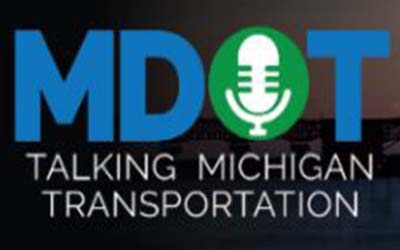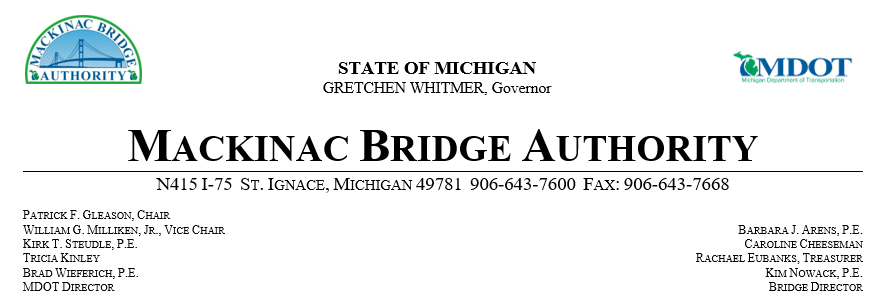
by orionontv | Jun 26, 2024 | Transportation
Blue Water Bridge eastbound span project update
Fast facts:
- The Michigan Department of Transportation (MDOT) expects to complete maintenance on the eastbound span of the Blue Water Bridge (BWB) in mid-October.
- Both directions of traffic are currently using the westbound bridge.
- Wide loads are restricted to less than 10 feet and dedicated lanes are not being provided for buses.
- Through the remainder of construction, the Pine Grove Avenue ramp to the toll plaza will be closed 9 a.m. Thursdays – 9 a.m. Saturdays.
PORT HURON, Mich. - The Michigan Department of Transportation (MDOT) has closed the eastbound span of the Blue Water Bridge (BWB) to complete critical maintenance, expected to be finished in mid-October. This project is managed by MDOT and will address required maintenance on the eastbound BWB span connecting Port Huron, Michigan, and Point Edward, Ontario.
During construction, both directions of traffic will be using the westbound span.
To reduce traffic congestion and improve safety on BWB and in the city of Port Huron, MDOT is closing the Pine Grove Avenue ramp to the toll plaza every Thursday at 9 a.m. until every Saturday at 9 a.m. throughout the rest of construction. This ramp closure will prevent congestion from impacting local streets in the community during peak travel times for bridge users. Pine Grove Avenue ramp traffic will be detoured via Pine Grove Avenue, westbound Hancock Street, westbound I-94, southbound Range Road, and eastbound I-94 to the BWB Plaza.
MDOT will continue to provide a dedicated toll lane for EDGE pass holders.
While MDOT completes this critical maintenance, the Federal Bridge Corporation Limited (FBCL) will address additional repairs on the eastbound span, much of which is occurring under the bridge deck. MDOT and FBCL are working closely to coordinate work and closures, reducing continual impact on commuters.
BWB customers should expect the following impacts for the remainder of construction:
- Dedicated lanes for buses are not being provided.
- Wide loads are being restricted to less than 10 feet.
The BWB is an essential economic link between Canada and the United States. This important project continues the commitment between MDOT and FBCL to maintain and preserve the safety and reliability of the BWB.
For more information:
Dave Smith
MDOT BWB
810-434-3274
SmithD134@Michigan.gov
Jocelyn Garza
MDOT Office of Communications
989-245-7117
GarzaJ10@Michigan.gov

by orionontv | Jun 18, 2024 | Transportation
|
MDOT seeks feedback from vulnerable road users
through survey and open houses
Fast facts:
- MDOT is surveying Michigan residents on vulnerable road user safety.
- A vulnerable road user includes anyone walking, biking or rolling (nonmotorized forms).
- The 15-question survey is now available through Aug. 18.
LANSING, Mich. – The Michigan Department of Transportation (MDOT) is conducting a vulnerable road user safety assessment (VRUSA) through a 15-question survey and hosting several public open houses throughout the state to improve understanding of the conditions and behaviors present in fatal and serious injury crashes. VRUs include anyone walking, biking or rolling by nonmotorized forms of transportation on public roads or on foot in work zones.
Who:
Michigan residents
Community stakeholders
When and Where:
Thursday, June 20, 2024
3 – 7 p.m.
Henry Ford Centennial Library
Community Room M-15
16301 Michigan Ave.
Dearborn, MI 48126
Tuesday, July 2, 2024
11 a.m. – 3 p.m.
National Cherry Festival
Pop-up location
Traverse City, MI 49686
Wednesday, July 3, 2024
11 a.m. – 3 p.m.
Mackinaw City Welcome Center
710 S Nicolet St.
Mackinaw City, MI 49701
Wednesday, July 3, 2024
11 a.m. – 3 p.m.
St. Ignace Welcome Center
I-75 N Mackinac Bridge Plaza
St. Ignace, MI 49781
Tuesday, July 9, 2024
5 – 8 p.m.
Ypsilanti District Library – Superior
1900 N Harris Road
Superior Charter Township, MI 48198
Friday, July 19, 2024
11 a.m. – 3 p.m.
Ann Arbor Art Fair
Downtown – Pop-up location
Ann Arbor, MI 48109
Tuesday, July 23, 2024
3 – 7 p.m.
Herrick District Library – North Branch
Community Meeting Room
155 Riley St.
Holland, MI 49424
Thursday, July 25, 2024
3 – 7 p.m.
Hoyt Public Library
Auditorium
505 Janes Ave.
Saginaw, MI 48607
Accessibility:
Attendees who require mobility, visual, hearing, written or other assistance for effective participation should contact Orlando Curry at 517-241-7462 or CurryO@Michigan.gov, preferably at least five business days in advance. Forms are located on the Title VI webpage. Requests made outside of this timeframe will be evaluated and honored to the extent possible.
Background:
Although Michigan’s VRUSA was completed in 2023, in accordance with the Federal Infrastructure Investment and Jobs Act, MDOT continues to look for opportunities to engage and obtain feedback and continue VRU research. Every year, VRUs are killed or seriously injured on Michigan roads at a rate faster than other road users. With recognition of the importance of safe travel for all, especially VRUs, MDOT and statewide partners have begun to transition to the Safe System Approach (SSA). The SSA represents an evolutionary step in addressing roadway safety as it is human-centered. The SSA is founded on the principle that all humans make mistakes and that human bodies have a limited ability to tolerate crash impacts. It is a redundant system that strives to eliminate fatalities and serious injuries by reducing risks and anticipating mistakes.
Public Input:
For more information and to complete the survey, please visit the VRUSA survey website. |

by orionontv | Jun 13, 2024 | Transportation
New data finds Michigan drivers putting down their phones
On this week’s edition of the Talking Michigan Transportation podcast, a conversation with Ryan McMahon of Cambridge Mobile Telematics, a Massachusetts-based firm that tracks data from drivers, participating voluntarily, to analyze statistics and driver behavior.
Listen now: https://www.buzzsprout.com/1374205/15243078-new-data-finds-michigan-drivers-putting-down-their-phones


McMahon last spoke on the podcast in November, a few months after Michigan Gov. Whitmer signed the law making it illegal to use a hand-held electronic device while driving.
The news was less sanguine then, but now his firm is reporting updated numbers that show meaningful strides in the right direction.
Some key figures cited:
- In the first month after the Michigan law was signed, distracted driving went down nearly 12 percent.
- The next month, it was 13.5 percent lower.
- The gains then diminished but are headed in a positive direction again.
|
Michigan Hands-Free Law Impact
Data and graphs provided by Cambridge Mobile Telematics.
Before the Law
Average trips per day: 4.7
Minutes per trip: 20
Minutes driving per day: 95
Hours spent driving per day: 1.58
Phone motion seconds per hour: 108
Phone motion seconds per day: 171
Phone motion time per day: 2:51
|
After The Law
Average trips per day: 4.7
Minutes per trip: 20
Minutes driving per day: 95
Hours spent driving per day: 1.58
Phone motion seconds per hour: 95
Phone motion seconds per day: 151
Phone motion time per day: 2:30
|

Graph showing the Michigan hands-free law percentage change compared to one moth before the law.
Michigan Hands-Free Phone Motion Per Hour After

Graph shows relationship of phone motio seconds per hour for one month before law through 12 months.
Phone Motion Trends: Before & After Hands-Free Law

Graph shows phone motion trends before and after hands-free laws in Ohio, Alabama, Michigan, and Missouri.
|
|

by orionontv | Jun 6, 2024 | Transportation
How public transportation fuels economic development
On this week’s edition of the Talking Michigan Transportation podcast, a conversation about legislation that would appropriate economic development funds for community-based programs, including public transportation.
Listen now: https://www.buzzsprout.com/1374205/15206567-how-public-transportation-fuels-economic-development

This week’s guest, Jared Fleisher, who leads government affairs and economic development for Rock (Dan Gilbert’s family of companies), explains why he’s passionate about the proposed bills and their potential to enhance qualify of life across Michigan and attract and retain talent.

On Tuesday, June 4, Fleisher testified in support of the bills before the House Economic Development and Small Business Committee. He framed the issue as an economic development imperative as Michigan is among states struggling to grow its population.
Others supporting the legislation include Oakland County Executive Dave Coulter, the Michigan Municipal League, Traverse Connect, Mass Transportation Authority Flint, Market Van Buren, The Rapid, Renovare Development, the Michigan Public Transit Association, Transportation Riders United, SMART, and International Union of Operating Engineers Local 324.
Also discussed:
- How public transportation has helped transform Grand Rapids, with The Rapid’s many options including the state’s first bus rapid transit lines.
- Investments in infrastructure like bus rapid transit and M-1 rail spur development.
|
|
|

by orionontv | Jun 6, 2024 | Transportation

Mackinac Bridge repaving completion delayed
ST. IGNACE, Mich. – Completion of the first season of a two-season repaving project on the Mackinac Bridge’s north viaduct and approach truss spans has again been delayed, with completion now expected next week.
Citing rainy weather that has prevented paving, along with projected rain in weather forecasts, project contractor Zenith Tech estimates completion of remaining paving should be completed around the middle of the week of June 10.
Crews paved a portion of the bridge this past Monday and plan to pave today, completing the portions on the north end of the bridge. An expected total of three to four more full days of paving are needed to complete the work on the south portions of the bridge.
Based on forecasts, paving could resume as early as Saturday, June 8. The contractor is making a determination for paving each day by 10 a.m.
Repaving, deck repairs and joint repairs on the two northbound lanes of the bridge began March 25. Traffic is being maintained with one lane open in each direction during construction.
Weekend traffic peaks between 10 a.m. and 4 p.m., often resulting in traffic backups, even with all toll lanes open. Drivers should consider crossing at off-peak times or prepare for delays.
Wide-load restrictions are in place in both directions for any vehicles wider than 10 feet during construction. Wider loads will be allowed to cross once per day between 7 and 8 p.m. Monday through Thursday, with traffic stopped for brief periods to accommodate those crossings.
|

by orionontv | May 30, 2024 | Transportation

25 millionth Mackinac Bridge crosser returns to celebrate a 50-year anniversary
ST. IGNACE, Mich. – On May 21, 1974, Bob Kuchar was a 24-year-old General Motors employee on vacation when he crossed the Mackinac Bridge on his 1972 Suzuki 250 motorcycle. Turns out, he was riding the 25 millionth vehicle to cross the bridge since it opened in 1957.
On May 23, 2024, Kuchar made the trip again – crossing in his 2017 Ford F-150 this time – to mark the 50th anniversary (plus two days) of that momentous crossing.
“It was an experience for a 24-year-old, and it was just a cool feeling to be the 25 millionth across,” he said. “I couldn’t have been more welcomed by the Bridge Authority representatives from St. Ignace and Mackinaw City.”
While Kuchar, who is now 74, had planned to cross the bridge this time on his 2019 Husqvarna 350 FE dual-sport motorcycle, he instead carried it across in his truck due to concerns about crossing the bridge’s grating during gusty winds.
“To have my name associated with the iconic Mighty Mac, I’m no less humbled as I again was welcomed to visit with you all,” Kuchar said. “Some family and friends offered regrets that I didn’t get another picture of me on my cycle paying the toll, but most said, ‘maybe next time.'”
Though he’s crossed the bridge several times over the years, this crossing was just a day trip. After a quick tour of the Mackinac Bridge Authority (MBA) administration and maintenance facility, he enjoyed a lunch at Clyde’s in St. Ignace before heading home.
Back in 1974, when Kuchar was living in the Saginaw area, he was planning a trip all the way around Lake Michigan. He hadn’t expected the surprise at the Mackinac Bridge, which included a photo op with MBA Executive Secretary Lawrence Rubin and a prize package worth $500 donated by Straits-area businesses. It included hotel and meal vouchers, as well as a free tank of gas. Unfortunately, he had just filled up his four-gallon tank right before crossing.
As his trip continued around the lake, he stopped in Manitowoc, Wisconsin. An approaching storm scuttled the rest of his trip, and instead he crossed back across the lake on the ferry to Ludington. When he got home, his parents had several newspapers laid out on the kitchen table with articles about his historic Mackinac Bridge crossing.
Kuchar retired from DELPHI Automotive Systems in 2005 and now lives in Fruitport with his wife of 45 years, Jackie. The couple has three children and two grandchildren.















